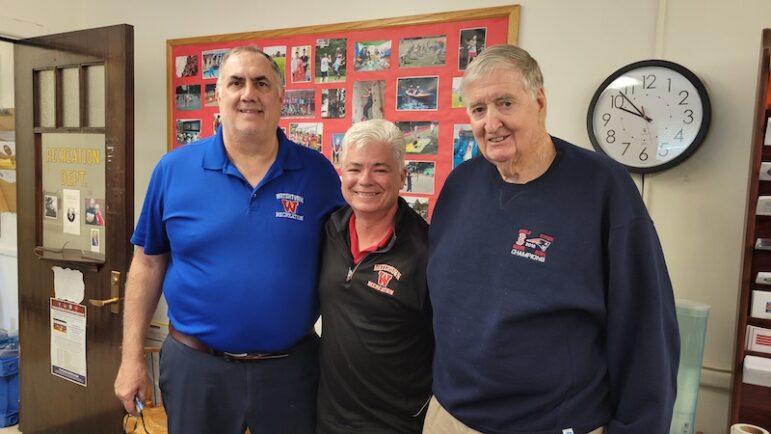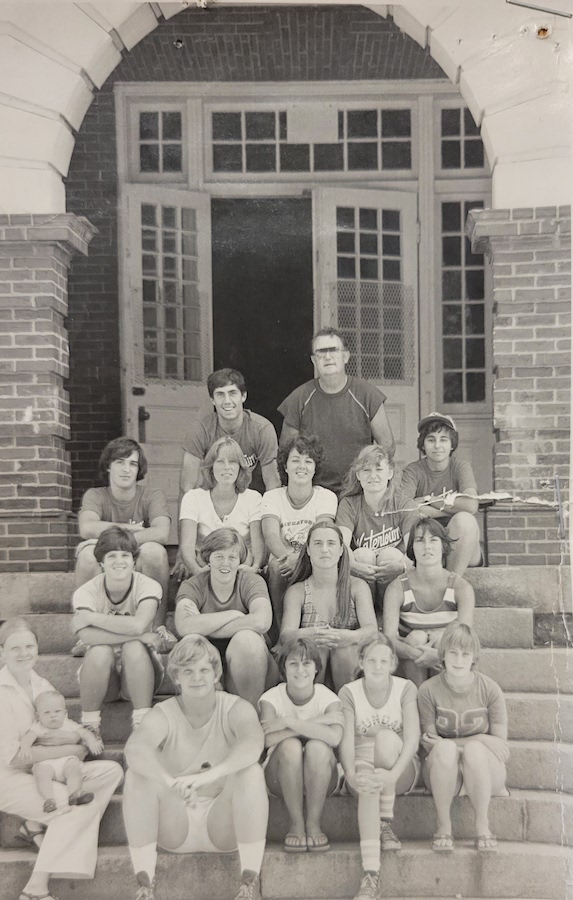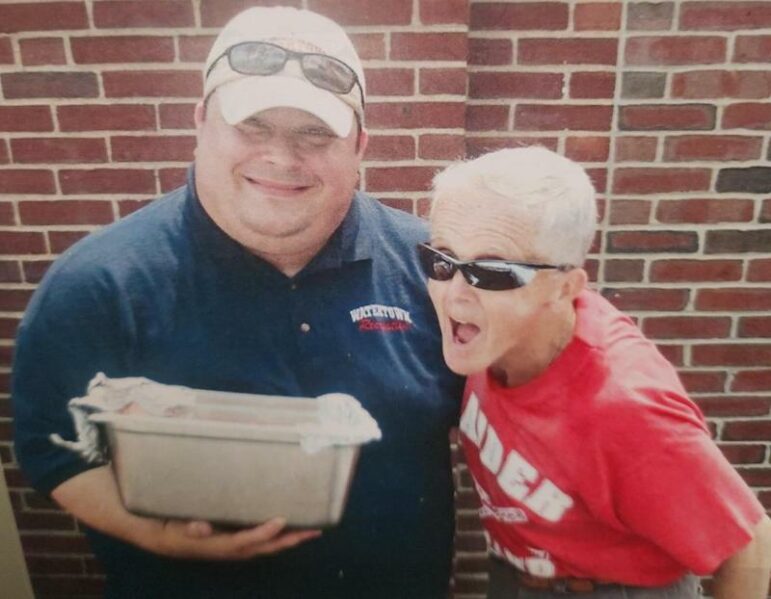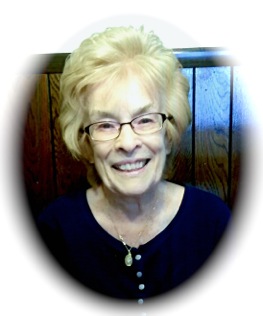
Charlie Breitrose Recreation Department staff current and past: (from left) current Director Peter Centola, Assistant Director Ernie Thebado and former Director Tom Sullivan.
From a young age, Tom Sullivan had an interest in parks, athletic fields and gyms. He even took detours on trips to get a closer look at something at a park in another community that caught his eye.
On May 3, 1973, Sullivan walked into his office on the top floor of Town Hall (where the Planning Department is now), to start his career as Watertown Recreation Director. He served in that position for 36 years, and continues to lend a hand and provide advice 50 years later.
Sullivan had worked for three years at what was known as the Waltham Boys Club prior to taking the job in Watertown.
“I used to run the gym at the Boys Club in the afternoon and at night I used to work a clubhouse at one of the projects. At the same time I was coaching basketball at St. Pats (High School),” Sullivan said. “This job came open and I applied and I was appointed. I was, what, 25 years old.”
When he arrived at Watertown Rec, there were more facilities, and but some of the programs that have become mainstays were just getting started, or didn’t exist at all.
“Camp Pequossette was somewhat in its infancy, and we had 12-14 playgrounds,” he said. “At Camp Pequossette if we got 100 kids in a session it was a good summer.”
When he took over, the Camp was located at Building 121 at the Watertown Arsenal, which is now part of Harvard Vanguard. Sullivan recalled that the building had been stripped of wiring and it had no heat. He tried to spruce it up by having a group of kids paint the insides, but it peeled off during the winter. After that, Camp Pequosette bounced around from the Parker School to the Lowell School to the Middle School.

When the first director, Vic Palladino, retired, Sullivan was approached by Phil Costello, a physical education teacher and a former Recreation Director.
“He was a tremendous boost,” Sullivan said. “That is when the camp started to mushroom, in the mid-’70s.”
When Costello retired, Sullivan talked his tennis instructor, Frank DiMascio, into being the camp director. Bob Gallante took over from DiMascio, and the current director is Brian Donato, who teaches at Watertown Middle School and is also Sullivan’s nephew.
“There have been five directors in a span of 55 years,” Sullivan said. “Brian, who is director now, started going there when was 5 years old. He’s been involved with the camp longer than I was director here.”
One of Sullivan’s goals was to make Camp Pequossette accessible to as many kids as possible.
“At one time I was at a meeting with the Chair of the School Committee and Vice Chair. They said we weren’t charging enough for Camp Pequossette and the School Department wanted to make some money off it,” he recalled. “But my thing was to make it affordable to all the people in the Town. It sustained itself.”
A program Sullivan started that continues today is the PreK Sports program, for three and four year olds.
“It was tough to get staff at that time. Fortunately, one of my buddies retired, Dick Crowley,” Sullivan said.
One winter, Sullivan helped run the program, and Crowley gave him some advice.
“He came to me and said when you get kids together and talk to them, I think you intimidate them with your size,” Crowley said. “So, I got down, kneeled down, so I was more at eye level. Like I say, I’m always learning.”
Sullivan is now approached by people in their 20s who say, “You were my coach in PreK Sports.”

Some of the town’s youth sports programs also started under Recreation, including girls softball, and the traveling team for basketball. The basketball program in the mid-70s was so popular that they had to have not just A and B teams at the elementary schools, but multiple B teams at Hosmer, the biggest school. Sullivan recalled one championship game was played in front of a packed gym at Watertown High School, and he had to referee the boys final. Afterward he was approached by a parent who did not hold his tongue when critiquing his officiating of the game.
The Recreation Department also ran after-school programs at each of the elementary schools, along with St. Patrick’s Parochial School, Sullivan said. The budget was low then, and each of the staff members got $100 a month.
The Staff
For many years, the Recreation Department’s full time staff consisted of Sullivan and his secretary, Anne Crimmins.
“She was the best, as far as meticulous, she was like clockwork,” Sullivan said. “By the end of the day, she knew how much was in each account — to the penny — and if she disagreed with the Auditor’s office by a nickel, she’d be up there proving them wrong. I never had to worry about budgeting. She just managed all that stuff.”

Eventually, the Recreation budget was increased so that Sullivan could hire an assistant director. He brought in Ernie Thebedo, who had been at the Watertown Boys & Girls Club for years.
Thebedo said he was happy to move over.
“I needed a change at that time and I saw the opportunity to work with Tom. We worked well over the year at Boys & Girls Club and biddy basketball and stuff like that,” Thebedo said. “And staying in the same community, I love this community. It took me in. If I could continue my journey in Watertown it would be a great thing.”
Watertown’s Parks
Two of Watertown’s biggest parks were built or expanded while Sullivan was the Recreation Director.
“For Arsenal Park, the Town purchased 55 acres from the Federal government back in the mid-’60s,” Sullivan said.
Ten percent, or 5.5 acres, of the land was earmarked for open space, but it grew to 13.4 acres. Sullivan recalled how the park expanded.
“There was the battalion parade ground, a basketball court and a green house that had all fallen apart. I said why not draw a line down there. That added 1.4, 1.6 acres to the project,” Sullivan said. “And then I was dealing with the (Arsenal) Redevelopment Authority and I became aware the foundry building had floors that were like 3 feet thick with rebar to take on a nuclear bomb. They didn’t know what they were going to do with that. I told a friend in Engineering, why don’t we draw a line around that. Why don’t we use the foundation for all the tennis courts and basketball courts? It became 13.4 acres.”
In around 1975, the Redevelopment Authority and Recreation Department were going to apply for funding from the Bureau of Outdoor Recreation, a federal agency that eventually was absorbed into the National Parks System, but the Conservation Commission wanted to review it first, Sullivan said. It came back the next year, and included about 90 percent of the original proposal, he recalled.
Later, when Watertown was looking for a place for a skateboarding park, it wound up at Arsenal Park after considering other locations, such as behind City Hall and at Watertown Middle School. It ended up at Arsenal Park, Sullivan said, and it was built with the help of a local electrical union.
When he became Recreation Director, Filippello Park was just four acres on Arlington Street. Current Recreation Director Peter Centola said: “Filippello Arlington (side) was the field, and where spray park is, that was the start of the (Watertown) dump.”
There was a proposal to sell the four acres to pay for development of the 10 acres where the dump was, Sullivan said. Then they decided to develop the whole 14 acres into park land. There was a challenge, however, because there was a big drop off from the field to the dump. At the same time, St. Elizabeth’s Medical Center in Brighton was expanding, and Watertown was able to get the dirt removed from that project to level out Filippello Park. That solved one problem, but created others, Sullivan said.
“I’m walking around the infield (of the softball diamond) one day and 10 t0 15 feet behind where the shortstop would play there is a piece of rebar sticking out of the ground. So we got this fill and all the stuff starts coming up: glass and all that,” Sullivan said.
A clay cap was put on the field to keep all the items from working its way through the soil to the surface.
Some of Sullivan’s contributions are smaller, such as putting a soft rubber matting around playground structures at a time when most had wood chips or sand.
“He goes out and finds it,” Centola said. “He goes out and looks at this, looks at this, looks at this, and he brought it back here.”
Sullivan said he remembers spending a lot of time at playgrounds and parks at an early age, like when he was “shipped down to New York” for a couple weeks each summer to be with his two aunts and grandfather. He would cross Riverside Drive to play ball with some kids every day at a park along the Hudson River.
“If I go anywhere I always check out parks,” Sullivan said, who recalled one trip on the Southern State Parkway on Long Island with one of his sisters. “I pulled off and she said, where are you going? I said, I saw something I want to look at. It was a park and they have a ball field, but they have a portable mound on it.”
He has also found examples of things to avoid, such as when he was in San Francisco and he went to a park where Joe and Dom DiMaggio played as boys.
“They had an idea to put a fence in front of the swing set,” he said. “The idea of the fence was to prevent people walking by from getting hit by people on the swings. But then people would see if they could swing and try to clear the fence.”
Impact
Sullivan said that his favorite part of being Recreation Director was the relationships he made with people he worked with and with the children in the programs. Some of the former campers and Recreation program participants have gone on to do great things, he said.
“I am blessed to have a lot of teachers, principals, even a couple of superintendents of schools,” Sullivan said.
Centola said one of Sullivan’s greatest impacts has been outside of the Recreation realm.
“I want to make sure he gets credit for all the stuff he’s done, more important is his life’s passion for his brother, Paul, who passed away,” Centola said. “His brother passed away in Vietnam. He and his family have a scholarship event in his honor each year, which has been second to none — giving scholarship opportunities to high school seniors.”
Sullivan can still be seen at Victory Field or at the gym at Watertown High School catching a game. He enjoys catching up with people, many of whom he knew from his time working in the Recreation Department.
“One of the biggest things is you make a lot of friends,” Sullivan said.
Thank you for this informative story about a wonderful man. A town treasure, Tom Sullivan gave so much to me and my cohort. A coach and teacher (and great athlete himself), Tom represents the best of Watertown. Thank you Tom.
The man in middle, Ernie, is the best, really super guy. Kids love him and he’s just a 100% positive, upbeat person. Watertown is lucky to have Ernie doing what he does.
Tom is the best. A Watertown legend and a very kind and decent man.
Thanks to Tom and his entire family for their love of Watertown, I think it all started for Tom, from his involvement with the Russo Landscaping Co. Thanks Tom again!
Tom gave his all for boys and girls in the recreation programs and for the town he so loved. We forget the contributions of those who are humble and unassuming. Tom was that kind of guy. Doing what needed to be done to serve our kids and doing without expectation for fame or fortune.